1. The weather in Vietnam
Vietnam is a long country, it is lengthened from the north through the central area to the south of Vietnam. Among, each of this area is appeared by each of a different kind of the weather.
The weather in the northern Vietnam
Different from the weather in the central and southern Vietnam, there are four seasons in the northern Vietnam is Spring, Summer, Autumn and Winter. Each season is included three months, and the first season in a year in the northern Vietnam is Spring: this season is lengthened from January to March, the temperature is around from 15 to 25 degree. Although this season has often appeared the small raining, this is a very beautiful season in a year, almost of the most important festivals of Vietnamese is organized in this special season.
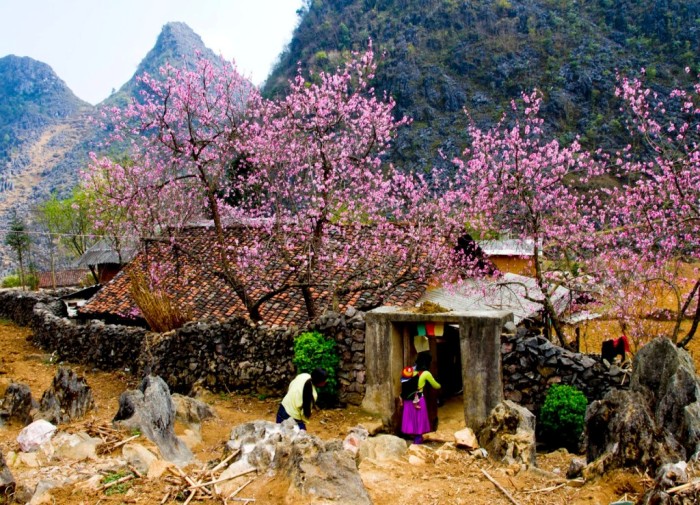
Spring in the northern Vietnam is the season for all kinds of flower open
Among important festivals in the spring of Vietnamese has the most important festival of Vietnamese is New Year, during all of cities and provinces from the smallest to the largest cities are showed a lot of the interested festivals, for example, the festival of Perfume Pagoda where is located nearby Hanoi, it is just far from Hanoi around 60km by bus, every year from January to March is there are so many domestic tourists from all cities and provinces of Vietnam from the central to the southern areas come here to take part in this special festivals, they come here in the first dates of the new year to pray for a happy whole year or there are also many another purposes to be wished at here such as there are also some tourists pray to have baby, some travelers want to rich….but almost people hope and want a year with the security and good health.
Besides the unique festival of Perfume pagoda, the festival of Ba Chua Kho Temple during the new year period of Vietnam is also very known and crowded by the travelers come here, with Vietnamese is this temple is considered as one of the most hallowed temples in the northern Vietnam, people also come here for the different purposes but their main purpose is always has a good health and rich…….

Enjoy a boat trip by a rowboat along the river in Perfume Pagoda in the spring festival
If you visit any place in the northern Vietnam in this spring, then you also should bring some thin warm clothes to prepare for the cold dates, on the other hand you do not need to bring a lot of the thick clothes to keep the spaces in your luggage to buy the pretty souvenirs in your trip to Vietnam.
The second season in the northern Vietnam is summer: This season is from April to June, the temperature of this summer season is around from 30C to 38C, although this season is hot, there are a lot of travel activities which are organized in this season because there are many children whose do not have to go to school at this time, almost families prefer to travel to the beautiful beaches of Vietnam such as Cua Dai beach in Hoi An, Phu Quoc island, Nha Trang beach city, Mui Ne beach in Phan Thiet….or there are also many another families prefer to the mountainous areas of Vietnam to enjoy the fresh air and meeting the ethnic groups in the northern Vietnam such as Sapa, Dien Bien Phu, Ha Giang….
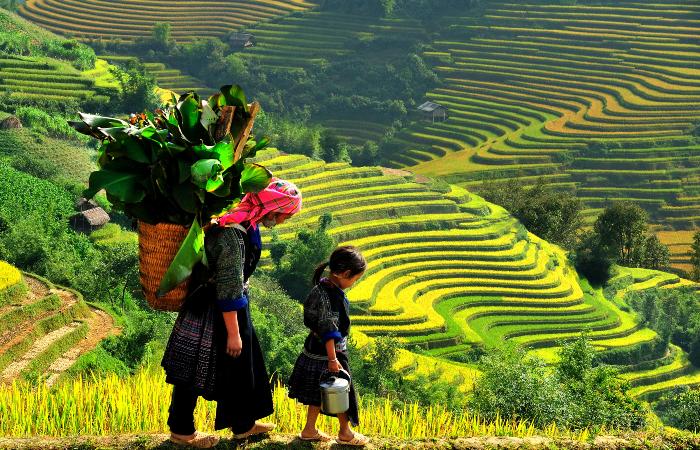
Sapa in the summer is the most beautiful time to travel and explore
You should bring the thin and light clothes if you travel to the northern Vietnam in this season, there are not much raining in this season, but sometimes you will meet the hard rainy but it is also passed fast so not worry, but there is one thing you should bring during your trip is water, the sunny will make you lost water very much while you can not find or buy water everywhere in the removed sightseeing in the northern Vietnam.
The third season in the northern Vietnam is Autumn: This season is still considered as the most beautiful one in four seasons in the northern Vietnam, this season is lengthened from July to September, the weather is always cool in this season because it is not too hot and not too cold as well, but sometimes there are some storms and heavy rain in this season so it is also not too convenient and ideal for the tourist to explore and relax at some beaches the northern Vietnam in this season, but it is fine for you to discover the mountainous areas of Vietnam such as Ha Giang, Sapa, Dien Bien Phu, Lai Chau….because there are not many storms which are appeared or come to these high areas of Vietnam, besides that Hanoi capital is also the safe place for you to avoid if there is any storm appeared in the northern Vietnam.

Autumn in Ha Giang one of the mountainous province in the northern Vietnam
The fourth season is winter, this is also the last season in the northern Vietnam in a year: The winter is lengthened from October to December, it is very cold, the coldest places are the remove provinces and destinations in the north of Vietnam such as Meo Vac in Ha Giang, Sapa, Dien Bien Phu, Lai Chau, Cao Bang…, the temperature in these mountainous areas is around 5C-20C. In the cities and provinces in the delta area is around 10C-25C.
You should bring some clothes with you if you travel to the northern Vietnam in this cold weather, although the temperature is around 10C-20C but it is very biting, it is not cold like in some foreign countries, the winter in the northern Vietnam is very hard and uncomfortable. But instead of that, the weather in this season is the most stable comparing with three seasons above, so this season is also the high season to travel around Vietnam.
The weather in the central Vietnam
The weather in the central area of Vietnam is often included two seasons, the wet and dry season but nowadays the weather in this area is little similar with the weather in the northern Vietnam although in the winter at here is not as cold as in the winter of the north. You can travel this area anytime in a year because the weather is not as hard as in the provinces of the north, you are still possible to visit all sightseeing although it is rain or sunshine, the rain at here is not too heavy and strong as well as the sunshine at here is not too hard, but the best time for you to visit this area is from December to May because this time is the dry season in this area, it is the wet season is from June to November, but you will always feel cool if you explore this area in the wet season. So, the time to travel to the center of Vietnam should depend on your condition, it should not depend completely on the weather at here because each of season has its own convenience and inconvenience.

Hoi An is considered as one of the cultural heritages in the world
While you are traveling to the center of Vietnam, you also do not need to bring a lot of the thick clothes because it is easy and comfortable about the weather anytime for you to travel this destination anytime. Furthermore, the center of Vietnam is also very famous with the cheap and good clothes, so do not bring too your clothes from your home is a chance for you to buy the new and cheap ones at here. Especially, you should tailor some clothes in Hoi An if you travel to this old town where is considered as one of the cultural heritage in the world, it is very very beautiful with the old town and the beach nearby.
The weather in the southern Vietnam
Quite different from the north and the center of Vietnam, the weather is encompassed clear two seasons is the wet and dry season, the wet season is around from May to November with a lot of rain, the dry season is from December to April with a lot of the sunshine, but the sunshine of this area is not as hot and hard as in the center and the north of Vietnam, it is much more comfortable because it has the high humidity, so you will not feel dry your skin as you live in the north.

Ben Thanh market in Ho Chi Minh City where you can buy anything
That’s why there are a lot of people whose like the weather in the southern Vietnam than the weather in the northern Vietnam, people whose lived in the southern Vietnam still say that they can not stand the hard weather of the north, but there are also many persons whose live in the northern Vietnam say that they want to experience four seasons in a years to have a chance to change their fashion as well as feel each different season once they live in the northern Vietnam.
2. The weather in Cambodia
Not like as in Vietnam, Cambodia has just two seasons in a year, it is the wet and dry season. The dry season is from December to April, the wet season is from May to November. Each season has its own beautiful, if you travel to Cambodia in the wet season you will have a chance to see water everywhere you arrive, you must take a boat trip many places while exploring Cambodia because it is the vast water.
And, one of the most beautiful sightseeing where is appeared the vast water is Tonle Sap lake, discovering this great lake you will have a chance to sit on a motor boat to run along river and lake and have a chance to see and find about the daily like the locals on their boats at here.
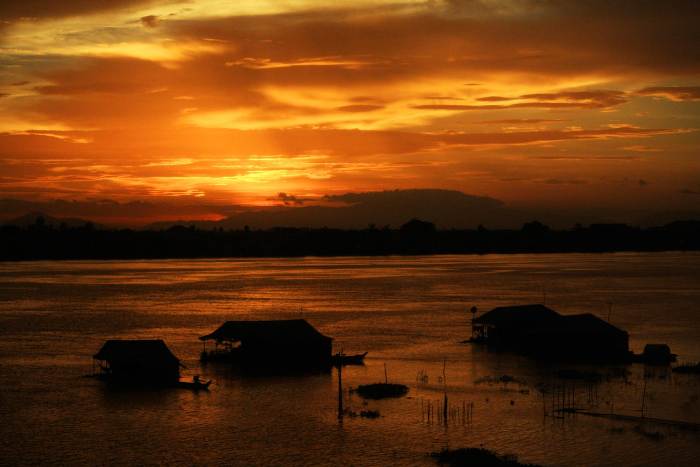
Tonle Sap lake in Siem Reap Cambodia in the wet season – this is the great lake and also the largest lake in Asia
In the dry season, you have a chance to experience the hot in Cambodia, it is very hot and the sunshine is full day from around 5 am to 6 pm, with the sun is raised very early in the morning and set late in the afternoon like this you will have a longer day so that you can visit more sights in Cambodia although you have a short time at here, especially Angkor Temples complex with Angkor Wat temple and other famous temples in this area.
It is very easy and convenient for you to bring your personal luggage once travel Cambodia because its weather is very stable, it is around 25C-38C all time. You just need to bring some thin clothes and it is enough. But, you always prepare an umbrella to travel around all sightseeing in Cambodia because the weather in the dry season is very sunshine but it is much rain in the wet season, so an umbrella with you on your trip to Cambodia is necessary and helpful.
3. The weather in Thailand
Also the similar as Cambodia, Thailand also has two seasons is the rainy and wet season. The rainy season is lengthened from May to November and the dry season is lengthened from December to April. In fact, even Thailand is in the rainy or the dry season is anytime it is also nice and worthwhile for you to explore this golden temple country, this country is encompassed fully the natural and cultural sightseeing and the most beautiful beaches so you can combine these to choose the most suitable with your period.
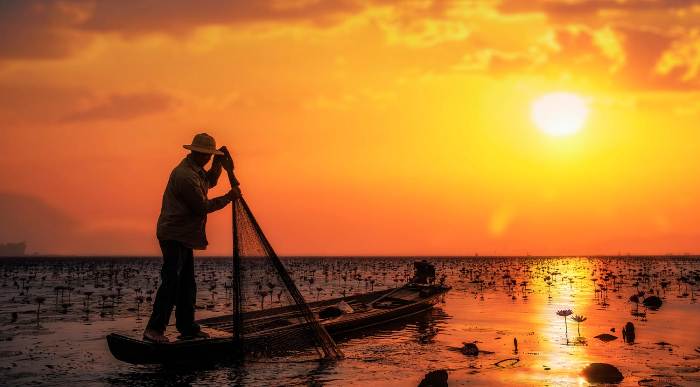
The Mekong River Delta in Thailand in the wet season
The dry season in Thailand is not like as the summer in the northern Vietnam, it is hot but it not hot as hard as like in the hot weather in Vietnam, the summer and dry season in Vietnam do not have much the humility like in Thailand so you will feel little more comfortable to stay in Thailand than Vietnam, but you will never feel a cool autumn and spring, a cold winter and a hot summer and you will have a chance to experience four seasons once travel Vietnam.
4. The weather in Laos
Laos is still a poor country and this poverty is a part to be caused by its hard weather, the hard conditions about nature make Laos very difficult to develop anything. Laos has the weather is similar to Thailand, Cambodia, and the southern Vietnam is Ho Chi Minh City, it has two seasons is the dry season from October to April and the wet season from May to September.

The dry fields in the dry season in Laos
Laos is still very famous with its dry season because in this season the sunshine and the hot wind of Laos is blown until to some cities and provinces of Vietnam such as Thanh Hoa, Dien Bien Phu, Lai Chau…it is really hot and inconvenient. But you will have a chance to visit an incredible country by the most friendly and kindest people, perhaps Laos is a unique country where still keep all its traditional habits and customs in Asian area. Visiting Laos you will not have to worry anything about the robbers, pillagers…Although the weather is very hard about both of the dry and wet seasons, it has much rain in the wet season and so hot in the dry season but instead of that you will explore a very neglected country where there have still not yet developed so much tourism as well as other industrial branches, so although the weather in Laos is hard, you also do not miss to visit this special and traditional country if you had a chance to go to Asian countries.
It is very convenient for your luggage to travel to Laos because you just need some thin clothes to be enough. If you must bring some warm and thick clothes in your luggage to travel in the winter of the northern Vietnam, then you do not have to worry about this if you travel to Laos anytime in a year.
5. The weather in Myanmar
Completely different from four countries Vietnam, Cambodia, Thailand and Laos. Myanmar has three seasons in a year, it is the hot season from March to April, the rainy season is from May to October, the cool season from November to February. But it is not so different from the rainy season with the cool season in this country, so normally it is considered as having just two seasons in this country is the rainy or wet season and hot or dry season.

Myanmar the country of the hallowed temples and pagodas
Myanmar is a Buddhist country, almost most famous sights and heritages in this country is the ancient temples and pagodas so the weather is not affected too much to your trip at here, it means that you can visit Myanmar (Burma) anytime through a year. But because the temperature in the hot season at here is sometimes raised 40C, so you should not visit Myanmar in March and April if you do not like the hot of this country.
6. The weather in India
India lies in southern Asia and is currently the second most populated country in the world and steadfastly increasing in economic power, despite the high presence of severe poverty and malnutrition in parts.
In the south of India, you will find the Indian Ocean coast, in the west, the Arabian Sea and the Bay of Bengal lie in the East, together these 3 water masses make up 7517 kilometres of coastline.
The climate in India is predominately influenced by the Himalayas and the Thar Desert which together drive the alternating monsoons which drive the weather changes in India.
India can basically be split up into 7 different climatic regions which play host to 4 different climates. As you move around India you will find a variety of weather conditions ranging from tropical wet to tropical dry and subtropical humid to montane.
Extending from 8 degrees north to 33 degrees north and with a wide variety of terrain, it is understandable why such a variety of weather conditions prevail. India is home to the highest mountain range in the world- the Himalayas, so here you will find permanent snowfields that are frozen year in year out. As you move south and head toward the tropical coastlands you will find conditions that are fairly typical of a tropical climate. In the vast plains of the Ganges valley, summers can get unbearably hot and even in the winter months the conditions stay fairly warm .
As a whole, India's climate is driven by the Asiatic Monsoon system which differs from any other weather system in the world in that the winds which determine the climate are ever changing from year to year, and there is no predictable weather pattern from year to year as the prevailing winds can change direction at any point in time.
JUNE to OCTOBER is when the south-west monsoon comes through India. In different parts of the country, the monsoon will come in at later periods, though on average it will hit in about June. During this time, in the mountains, very heavy rainfall is recorded.
The NORTHERN MOUNTAINS, in the Himalayas and at the foothills, you will find rainfall throughout the entirety of the year and some light snowfall come the winter months. Here the South West monsoon burst comes in about July and will last through until October.
Winters in this region are pleasant and fairly cool at the low levels, though conditions increase in extremity as you move to higher elevations.

An old white Buddhist stupa against the background of the snow-topped Himalayas.
The NORTHERN PLAINS extend from Punjab through to the Ganges delta. This region is low lying and in parts of the west, the terrain and the weather verges on the desert like. Here, particularly in summer, the conditions are hot and somewhat uncomfortable. From March to June it is generally completely dry with no relief from the blistering heat.
When the 'monsoon bursts' (as they say in India) come July, there is little relief from the heat. While the temperature does drop slightly when the rains come, the increase in humidity makes the conditions just as unbearable as in the hottest months. As you move further east the rainfall begins to decrease and you hit more arid conditions, particularly west and North West of Delhi.
If taking a look at the lowlands a good comparison to make is between Calcutta, which lies in the west East and New Delhi which is located in the dry west.
Calcutta is located in the east of Indian upon the east bank of the River Hooghly. In April and May, the average maximum is a blistering 36 degrees, and the minimum only falls to 24 and 25 degrees respectively come sundown. However, as Calcutta is 'cooled' by the presence of the Bay of Bengal, the temperatures here are actually quite a bit cooler than what the residents of New Delhi suffer through in the height of summer, before the onset of the south-west monsoon.
In May and June in New Delhi, the average maximums sit at 41 and 39 degrees respectively. In May on 13 mm of rain falls, on average , so there is very little relief from the heat. In June rainfall picks up to 74mm, before peaking at 180mm by July.
If you compare this rainfall to Calcutta in the wetter east coast, May sees rainfall of 140 mm, June picks up to 297mm on average for the month before seeing over 300mm monthly throughout July and August.
New Delhi sees slighter more hours of daily sunlight than Calcutta, however, while temperatures across the year are much higher in the west, the humidity in Calcutta in the east is considerably higher.
THE WEST COAST
Here you will find a narrow coastal plain which has the steep Western Ghats mountains rising behind the plain. Here rainfall is abundant and can be quite heavy at times, particularly during the south-west monsoon.
Mumbai (formerly Bombay) is located in this region, and conditions here are fairly indicative of what weather prevails at sea level. The weather in Mumbai is tropical and is home to two seasons- both of which are fairly enjoyable. Mumbai is known for its high standard of living and business opportunities, as well as being the homeland for 'Bollywood' – the Hindi film and television industry. Mumbai attracts immigrants from all over India as well as the world, so as a result, it is an interesting and multicultural city.
The humid season in Mumbai is between March and October and is characterized by high humidity and temperatures over 30 °C. The average high during April, May and June is 32- 33 degrees and the minimum only falls to 26-27 degrees. Rainfall is at its highest during June and July, particularly in July when average precipitation for the month is an astounding 617 mm! This is as a result of the monsoon rains which from June to September lash the city and result in most of the city's annual rainfall- 2,200 millimetres. On the 26th of July 2005, the highest ever rainfall recorded in a single day fell when an astonishing was 944 mm in a single 24 hour period.
The dry season in Mumbai, typically from November to February, sees moderate humidity and warm to cool weather. From January to February, cold northerly winds bring a mild chill through the area. Average minimums during this time are still a pleasant 19 degrees, maximums sit at about 29 degrees and rainfall is only about 2.5mm per month. Daily sunshine during this time is about 9 to 10 hours, which is a stark contrast from the 2 to 3 hours of sunlight during the cloudy months of July and August!
,%20India,%20Asia.jpg)
Gate of India and hotel Taj Mahal Palace in Mumbai (formerly Bombay), India.
THE RAJASTHAN DESERT is dry and, well, desert-like. In almost all parts of this region rainfall is below 500mm annually and in some parts no more than 250mm of rain will fall in an entire year. In the hottest time of the year, from May to July, this region is in fact one of the most excruciatingly hot places in the whole world. Even when the south-west monsoon comes there is little temperature difference and instead, it brings high humidity which makes for very oppressive conditions- particularly in July, August and September.
%20with%20camels%20silhouettes%20in%20dunes%20of%20Thar%20desert%20on%20sunset_%20Jaisalmer,%20Rajasthan,%20India.jpg)
Two Indian cameleers in the Rajasthan Desert, India.
THE SOUTHEASTERN COASTLANDS don't witness their main rainfall until well into October, and they last through until December. This region is prone to tropical storms and cyclones that develop over the Bay of Bengal. Like many places in India when the south-west monsoon bursts, temperature and humidity increases and light clothes are a most in order to stay comfortable in the unpleasant conditions.
The southern coast was hit by the 2004 Boxing Day tsunami which killed 10,136 people across the country- with hundreds of thousands left homeless. In Tamil Nadu which is on the eastern coast, 7,960 alone were killed and 500, 000 were evacuated from the area.
The tsunami was triggered by an underwater near the Indonesian island of Sumatra which registered 9.0 in moment magnitude, making it the biggest earthquake in four decades.
The ASSAM region, in the very northeast, is almost completely detached from India by Bangladesh. The conditions for Dhubri are the more representative of what weather prevails in the lowlands here.
It is cooler here than in other parts of India, in the hottest months of May to September the average maximum sits at about 30 degrees, though humidity can be quite uncomfortable during this time- particularly in the mornings when average relative humidity is about 90%! June is the wettest month, averaging 605mm of precipitation. Which falls across 18 days of the month. December, January and February average only 1 (if that) days of rain for the month and less than 10mm of rain will fall across each month.

Goa, South West India.
7. The weather in Philippines
The Philippines is a country in South East Asia made up of over 7100 islands. It's a country of radiant smiles and incredibly beautiful exotic nature.
In an average season, lasting from November to May, some 5 million people from different corners of the globe visit. Staying in the Philippines offers everything from bustling cities and malls and inner peace in the lap of pristine nature. Many Philippine resorts are ideal conditions for a beach holiday.
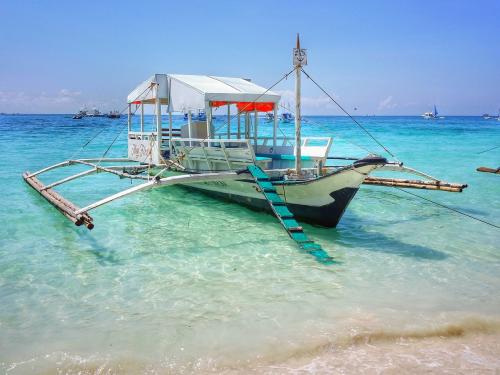
Tourists who enjoy an active lifestyle, come to the Philippines to surf some very secluded breaks. Here you can not only surfing, but also wind and kite surfing. Surf is found almost on every island but at different times of the. For example, on the East coast it is best to go between November to April. In the summer the most "quoted" the Western part of the archipelago, characterized in this season, stable winds. So, for Siargao, inhabited by mostly professionals, the ideal conditions remain at all year round, but the best waves are observed in September-October.
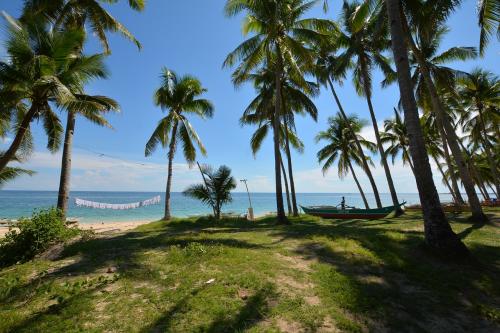
The Philippines have a hot tropical monsoon climate type, which is formed in the archipelago with two main seasons: wet — with a relative time frame from may to November and dry from November to April. Year round weather characterized by high temperatures and a high level of relative humidity, which with the advent of summer months is virtually 100 percent.
Spring in the Philippines
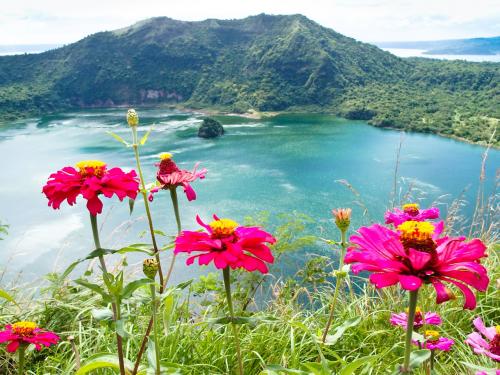
In March, there is a small but nonetheless noticeable increase in daily temperatures. At this time the archipelago is dominated by Sunny and dry weather. April along with May, is the hottest month of the year: during the day the temperature can rise to +35 °C (95 °F).
The Philippines ranks highly as one of the finest places on the planet for diving. This country has a huge number of dive sites, mainly concentrated in Boracay, Batangas, Cebu, Mindoro and Palawan. The underwater world of the archipelago is so bright and spectacular that it presents many surprises, and encounters with marine life. The Kingdom of Neptune dazzles with a variety of coral gardens (including blue), between which branches and scurrying flocks of colorful tropical fish, it is likely to see giant sea turtles, barracudas, sea cucumbers and whale sharks. The best time for diving is from November to May, when it is possible to achieve visibility under water up to 50 meters. However, be aware that at some dive sites, these dates may shift slightly depending on weather and geographical location. The reefs of Tubbataha offer the most comfortable conditions for diving between March and the end of June.
Climate of the Spring Months
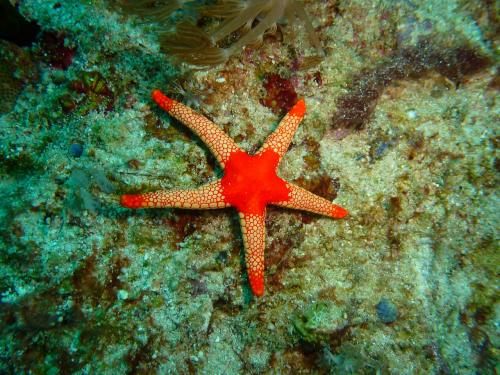
| March Max average t°: +33 °C (91 °F) Min average t°: +22 °C (72 °F) Water t°: +27.5 °C (82 °F) Sundial in the day: 8 hours Rainy days: 1 day Precipitation: 13.5 mm (0.5") |
| April Max average t°: +34 °C (93 °F) Min average t°: +23 °C (73 °F) Water t°: +29 °C (84 °F) Sundial in the day: 9 hours Rainy days: 2 days Precipitation: 15.5 mm (0.6") |
| May Max average t°: +34 °C (93 °F) Min average t°: +24 °C (75 °F) Water t°: +30.5 °C (87 °F) Sundial in the day: 8 hours Rainy days: 6 days Precipitation: 67 mm (2.6") |
(Manila)
Spring Holidays
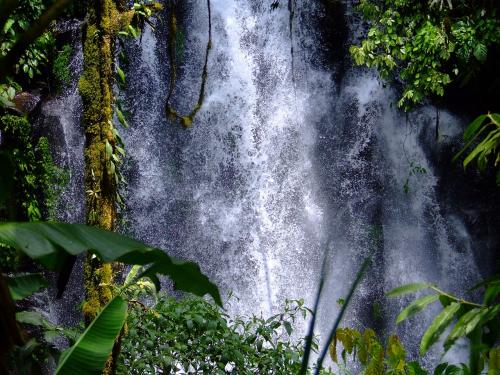
March-April — Easter;
April, 9 — Day of valour;
May, 1 — labour Day.
Summer in the Philippines
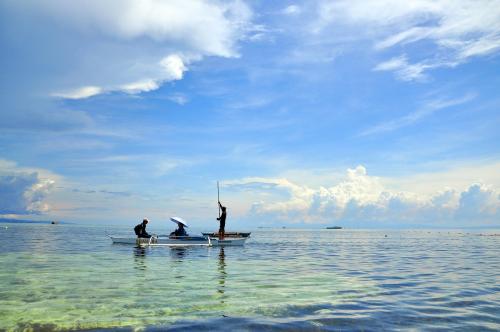
Summer in the Philippines "raging" passions. At least 20 to 30 rainy days because the impact of the southwest monsoon, humidity level soar to the maximum. That's why summer weather, only one degree greater than the winter temperature data is transferred is much more difficult. A feeling of stuffiness does not leave and in the evening, which due to the long daylight comes rather late. The air just does not have time to cool, so the temperature falls to an average of +27 °C (81 °F).
June is the most busy month in terms of natural disasters, however, swimming in the sea, warmed to a state of fresh milk, is not nice for everyone. Often due to the large disturbance of the sea throws to the shore algae, causing water blooms heavily, exuding an unpleasant smell. In July and August the rainfall is much stronger and longer. Because of the abundance of rainfall often floods and mudslides, paralyze large areas. In addition, in some regions, devastating typhoons hit. In general, summer weather does not allow much relief.
Typhoons can hit the Philippines at any time of the year with the months from June to September being the most active
The southwest monsoon rain clouds, leading to periodic heavy rains for roughly 10-11 days of the month.
Climate of the Summer Months
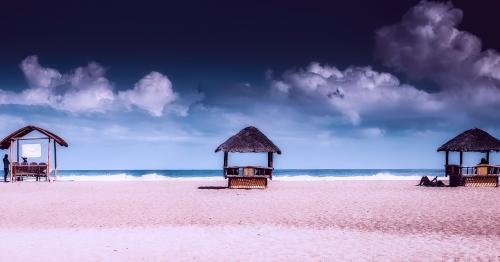
| June Max average t°: +33 °C (91 °F) Min average t°: +24 °C (75 °F) Water t°: +30.5 °C (87 °F) Sundial in the day: 7 hours Rainy days: 11 days Precipitation: 131 mm (5.2") |
| July Max average t°: +31 °C (88 °F) Min average t°: +24 °C (75 °F) Water t°: +30 °C (86 °F) Sundial in the day: 7 hours Rainy days: 15 days Precipitation: 319 mm (12.6") |
| August Max average t°: +31 °C (88 °F) Min average t°: +24 °C (75 °F) Water t°: +29 °C (84 °F) Sundial in the day: 7 hours Rainy days: 22 days Precipitation: 230 mm (9.1") |
(Manila)
Summer Holidays
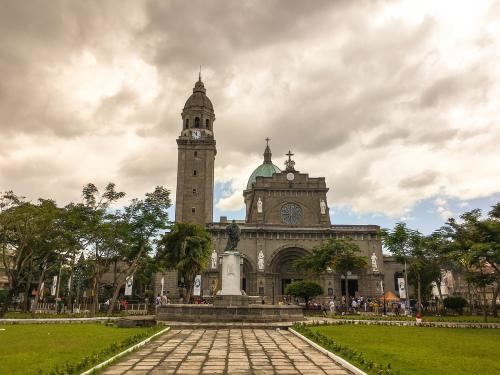
June, 12 — independence Day;
August, 21 — anniversary of the death of Benigno Aquino.
Autumn in the Philippines

The first half of autumn in the climate plan is not much different from July and August. Rains come almost every day, hot weather persists. Slightly less risk of precipitation of the North-Western part of Miranda, the East of the Islands of Cebu, Mindoro, Panay and Negros. Catastrophic flooding, typhoons (particularly in Wikisky Islands and the largest island of Luzon) ,until the end of October.
November can be called a crucial period when in most parts of the archipelago there is a significant improvement of weather conditions, but quite comfortable staying on the Islands.
Climate of the Autumn Months
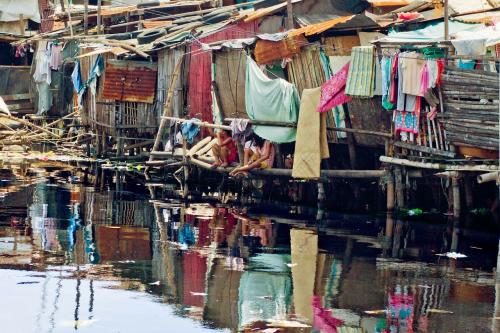
| September Max average t°: +31 °C (88 °F) Min average t°: +24 °C (75 °F) Water t°: +29 °C (84 °F) Sundial in the day: 6 hours Rainy days: 18 days Precipitation: 224 mm (8.8") |
| October Max average t°: +31 °C (88 °F) Min average t°: +23 °C (73 °F) Water t°: +29 °C (84 °F) Sundial in the day: 6 hours Rainy days: 13 days Precipitation: 119 mm (4.7") |
| November Max average t°: +31 °C (88 °F) Min average t°: +22 °C (72 °F) Water t°: +28 °C (82 °F) Sundial in the day: 6 hours Rainy days: 9 days Precipitation: 135 mm (5.3") |
(Manila)
Autumn Holidays
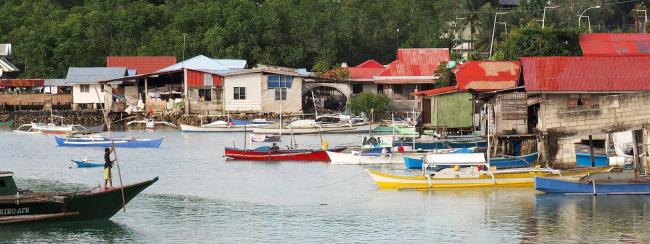
November, 1 — all saints day;
November, 2 — all souls day;
November, 30 — birthday of one of the leaders of the Philippine revolution, Bonifacio.
Winter in the Philippines
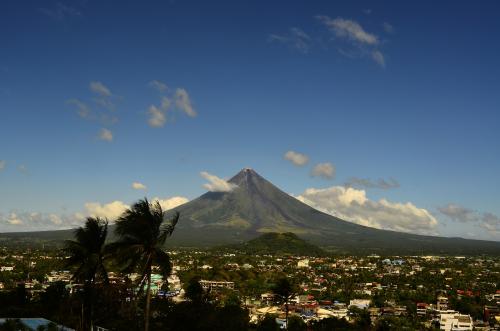
Winter in the Philippines is high tourist season, since the rains, hurricanes and typhoons are at the least. Weather stabilizes, it becomes much drier and a little cooler due to the influence of northeast winds. However, some resorts in the Eastern part of the archipelago may experience heavy rains. As a rule, they begin in the evening or at night, but in the morning the sky is striking in its "purity".
The lowest temperature recorded high in the mountains and in the Central part of the country, several in the South hotter than the North. Evenings are very pleasant, as the air is cooled to +23 °C (73 °F). This is the perfect time for a beach holiday: the temperature of water and air in perfect proportions, strong waves there, and the sun isn't as aggressive as in the summer.
Climate of the Winter Months
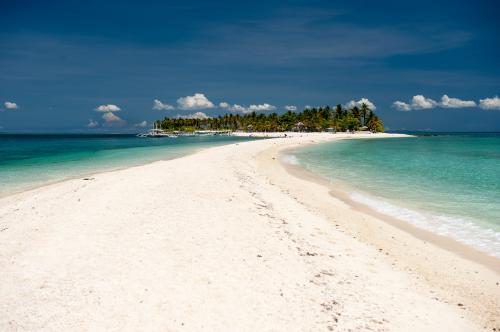
| December Max average t°: +30 °C (86 °F) Min average t°: +21 °C (70 °F) Water t°: +27.5 °C (82 °F) Sundial in the day: 6 hours Rainy days: 7 days Precipitation: 82 mm (3.2") |
| January Max average t°: +30 °C (86 °F) Min average t°: +21 °C (70 °F) Water t°: +26.5 °C (80 °F) Sundial in the day: 6 hours Rainy days: 3 days Precipitation: 27 mm (1.1") |
| February Max average t°: +31 °C (88 °F) Min average t°: +21 °C (70 °F) Water t°: +26.5 °C (80 °F) Sundial in the day: 7 hours Rainy days: 2 days Precipitation: 13 mm (0.5") |
(Manila)
Winter Holidays
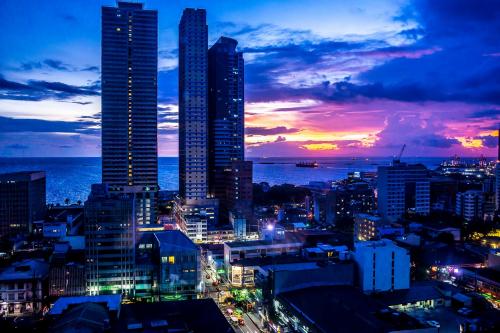
December, 30 — the birthday of national hero rizal;
December 31 — New year's eve;
January, 1 — New Year;
February, 25 — people power revolution anniversary.




